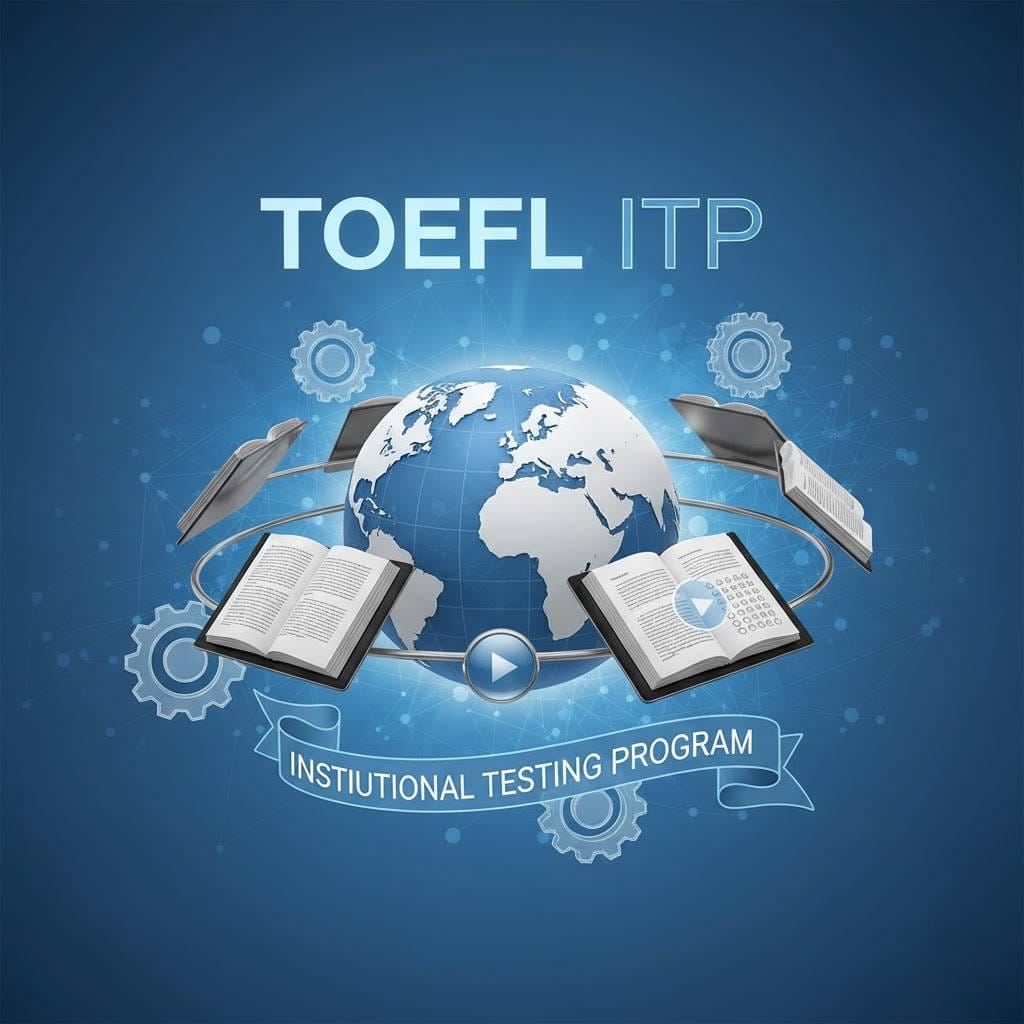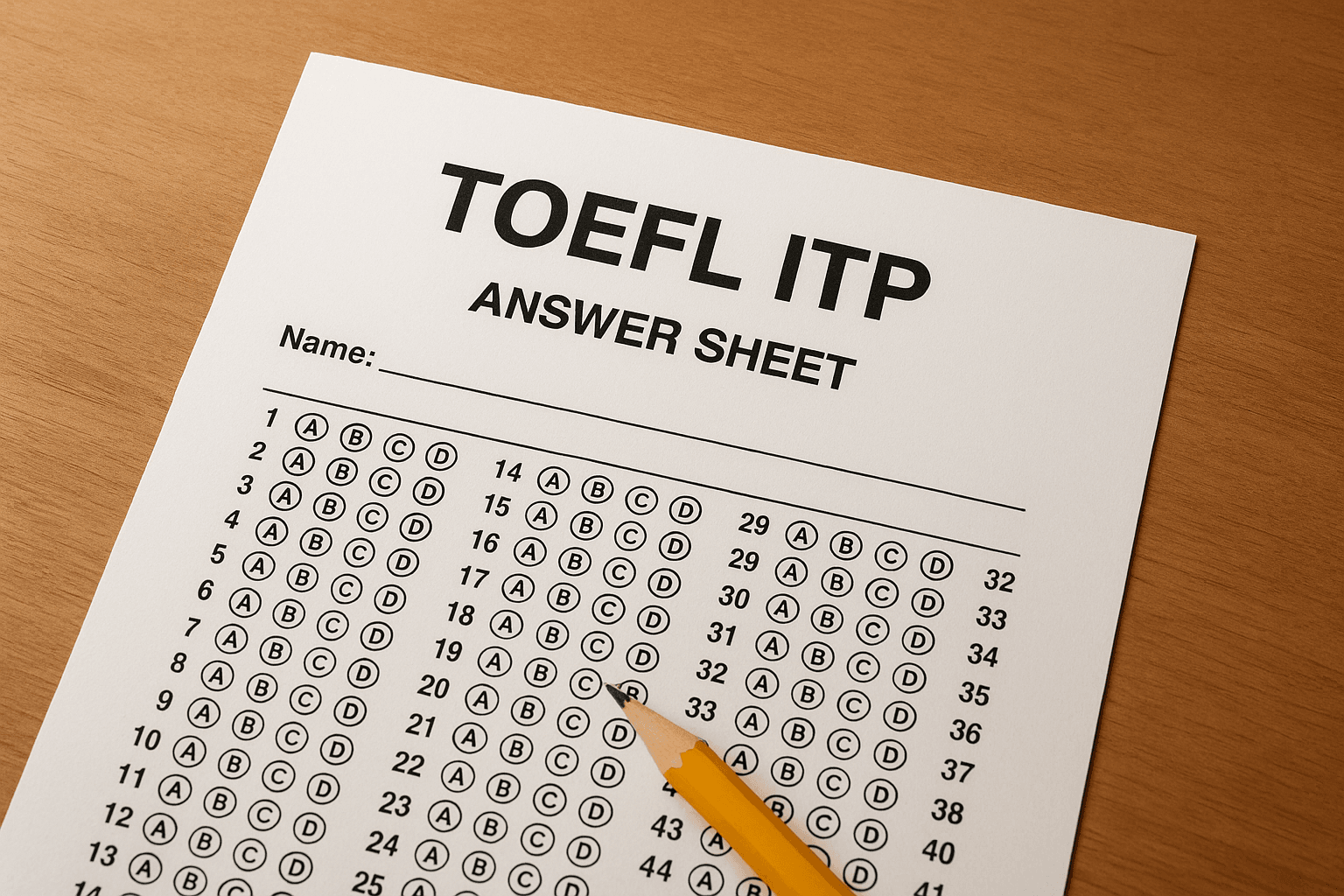Navigating the world of English proficiency tests can be complex, with various exams designed for different purposes. One such test is the TOEFL ITP. While many are familiar with the TOEFL iBT, the Institutional Testing Program (ITP) serves a unique and important role for academic institutions and their students. At Bolsa25 Academy, we believe in empowering our students with clear, comprehensive knowledge to make informed decisions about their educational journey. This guide will demystify the TOEFL ITP, covering its structure, scoring, and purpose, and provide expert preparation tips to help you succeed.
What is the TOEFL ITP?
The TOEFL ITP (Institutional Testing Program) is an English proficiency assessment from ETS (Educational Testing Service), the same organization that creates the TOEFL iBT. However, its purpose is fundamentally different. The TOEFL ITP is primarily used by educational institutions, government agencies, and other organizations for internal purposes, such as placing students in appropriate English language programs, monitoring their progress, evaluating program effectiveness, and for exit testing. It is a paper-based or digital multiple-choice test that assesses skills in Listening Comprehension, Structure and Written Expression, and Reading Comprehension. Unlike the iBT, it is generally not used for university admissions in English-speaking countries, which typically require the more comprehensive iBT exam.
Why is it used?
Institutions rely on the TOEFL Test (ITP) for several key reasons. It offers a convenient, affordable, and reliable way to gauge the English proficiency of non-native speakers within a specific context. Key uses include:
- Placement: Universities and language schools use ITP scores to place students into the correct level of English language courses, ensuring they receive instruction appropriate for their skills.
- Progress Monitoring: By administering the test at different points in a program, educators can track students’ improvement over time and assess the effectiveness of their teaching methods.
- Exit Requirements: Some non-English-speaking universities use the TOEFL ITP as a graduation requirement, ensuring their students have achieved a certain level of English proficiency before receiving their degree.
- Scholarship Programs: It can be used as a screening tool for scholarship programs that require a baseline of English ability before considering applicants for further evaluation.
- Workplace Assessment: Companies may use it to assess the English skills of employees for training programs or internal promotions, especially in a non-English-speaking environment.
Essentially, the TOEFL ITP provides a valuable internal benchmark for institutions, offering a snapshot of a student’s academic English skills without the high stakes and logistical complexity of the iBT.

TOEFL ITP Structure and Format
The TOEFL ITP test is divided into two levels: Level 1 (intermediate to advanced) and Level 2 (high-beginner to intermediate). Both levels are comprised of multiple-choice questions. The most commonly administered version is Level 1. Additionally, there is an optional Speaking test that can be taken with the digital version. Let’s break down the core sections of the Level 1 test.
Listening Comprehension
This section measures your ability to understand spoken English in academic settings. You will listen to short conversations, longer conversations, and short lectures, and then answer questions about them. The recordings feature North American accents.
- Number of Questions: 50
- Time Limit: Approximately 35 minutes
- Content: The conversations and lectures cover a range of topics you might encounter in a university environment. Questions test your ability to understand main ideas, important details, implied meanings, and the speaker’s purpose or attitude.
Structure and Written Expression
This section is designed to test your knowledge of standard written English grammar and structure. It is divided into two parts:
- Part A (Structure): Consists of 15 questions. Each question presents an incomplete sentence, and you must choose the word or phrase that best completes it.
- Part B (Written Expression): Consists of 25 questions. Each question presents a sentence with four underlined words or phrases. You must identify the one underlined part that is grammatically incorrect.
- Total Questions: 40
- Time Limit: 25 minutes
This section is a pure test of grammar rules, from verb tenses and subject-verb agreement to clauses, prepositions, and word order. It requires a strong foundational understanding of English syntax.
Reading Comprehension
This section assesses your ability to read and understand short academic passages. The topics are similar to what you would find in a first-year university textbook, covering subjects in the arts, sciences, and social sciences.
- Number of Questions: 50
- Time Limit: 55 minutes
- Content: You will read several passages and answer various multiple-choice questions about them. Questions focus on main ideas, details, vocabulary in context, inferences, and the author’s purpose. You do not need prior knowledge of the topics; all the information needed to answer the questions is in the passages.
An optional Speaking test is also available for the digital TOEFL ITP online version, which takes about 15 minutes and evaluates your ability to communicate in everyday and basic academic situations.
TOEFL ITP Scoring System
The scoring for the TOEFL ITP is different from the iBT. There is no “pass” or “fail” score; rather, you receive a scaled score that reflects your proficiency level. For the Level 1 test, the scores for each of the three sections are converted to a scaled score. These three scaled scores are then added together and multiplied by 10/3 to produce a total score.
- Listening Comprehension Score Range: 31–68
- Structure and Written Expression Score Range: 31–68
- Reading Comprehension Score Range: 31–67
- Total Score Range: 310–677
The TOEFL ITP max score for the Level 1 test is 677. Institutions set their own minimum score requirements based on their specific needs. For example, a university might require a score of 550 for entry into a specific program, while a language school might use the scores to place students into different course levels.
These scores are also mapped to the Common European Framework of Reference for Languages (CEFR), which provides a standardized description of language ability. For instance:
- A score of 627 or higher typically corresponds to the C1 (Advanced) level.
- A score around 543 corresponds to the B2 (Upper-Intermediate) level.
- A score around 460 corresponds to the B1 (Intermediate) level.
This mapping helps institutions understand a student’s proficiency in a global context.
Who Needs TOEFL ITP?
The primary audience for the TOEFL ITP is non-native English speakers who are already part of an institution that uses the test for internal evaluation. You might need to take this test if you are:
- A student at a university in a non-English-speaking country where the test is used for placement in English courses or as a graduation requirement.
- Enrolled in an English language program that uses the ITP to measure progress and determine when a student is ready to advance to the next level.
- Applying for a local or regional scholarship that uses the ITP as an initial screening tool.
- An employee at a company that uses the test to assess English skills for professional development programs.
It is crucial to understand that if you are applying for admission to a university in the United States, Canada, the U.K., or Australia, you will almost certainly need to take the TOEFL iBT, not the ITP. Always check the specific requirements of the institution or program you are applying to.
What is the difference between TOEFL iBT and ITP?
The main difference lies in their purpose and format. The TOEFL iBT is used for university admissions worldwide and tests all four integrated skills . The TOEFL ITP is for internal institutional use and primarily tests passive skills through multiple-choice questions. The iBT is a more comprehensive and widely accepted test for high-stakes decisions.
| Feature | TOEFL ITP (Institutional Testing Program) | TOEFL iBT (Internet-Based Test) |
| Primary Purpose | Internal institutional assessment (placement, progress monitoring, exit testing). | University admissions, professional licensing, and immigration worldwide. |
| Acceptance | Accepted by the institution administering it; not widely accepted for university admissions. | Accepted by over 13,000 institutions in more than 160 countries. |
| Format | Paper-based or digital; all questions are multiple-choice. | Internet-based; includes a mix of multiple-choice and open-ended tasks (speaking and writing). |
| Skills Tested | Listening, Structure & Written Expression, Reading. An optional Speaking test is available. | Integrated skills: Reading, Listening, Speaking, and Writing. Tasks often require using multiple skills at once. |
| Speaking Section | Optional, 15-minute test with four tasks. Scored separately. | Mandatory, integrated into the test. You speak into a microphone in response to prompts. |
| Writing Section | No dedicated writing section. Skills are tested indirectly via multiple-choice grammar questions. | Mandatory, with two tasks: one integrated (read/listen/write) and one independent essay. |
| Score Scale | 310–677 (for Level 1). | 0–120 (30 points for each of the four sections). |
| Test Length | Approximately 2 hours. | Just under 2 hours. |
In summary, the TOEFL ITP vs iBT debate comes down to purpose. The iBT is a comprehensive assessment of your ability to use English in an academic environment and is the global standard for admissions. The TOEFL ITP is a more streamlined, institution-focused tool for internal evaluation.
Preparation Tips for TOEFL ITP
Success on the TOEFL ITP requires a focused study plan that targets the specific skills and question types you will encounter. Here are some expert strategies from Bolsa25 Academy to guide your TOEFL Preparation.
General Strategies
- Understand the Format: Before you do anything else, familiarize yourself with the structure of the test, the number of questions in each section, and the time limits. Knowing what to expect is the first step to building confidence.
- Take a Diagnostic Test: Start with a TOEFL ITP practice test to gauge your current level. This will help you identify your strengths and weaknesses, allowing you to create a targeted study plan.
- Create a Study Schedule: Consistency is key. Allocate specific times each week to study for the test. A balanced plan should include time for each of the three sections, as well as vocabulary building and grammar review.
- Use Official Materials: Whenever possible, use practice materials from TOEFL ITP ETS, the test maker. This ensures that the questions you practice with are authentic and accurately reflect the difficulty and style of the real exam.
Tips for the Listening Section
- Practice Active Listening: Don’t just hear the audio; listen actively. Try to anticipate what will be said next, identify the main idea, and pay attention to the speaker’s tone.
- Focus on Keywords and Signal Words: Listen for words that indicate transitions (e.g., however, therefore, in contrast), introduce examples (e.g., for instance), or signal a conclusion (e.g., in summary).
- Improve Your Note-Taking: You are allowed to take notes. Develop a system of abbreviations and symbols to quickly jot down main points, names, dates, and key details. Don’t try to write everything.
- Expose Yourself to Academic English: Listen to English-language podcasts, university lectures (available on YouTube), and documentaries on a variety of academic subjects. This will help you get used to the speed and vocabulary.

Tips for the Structure and Written Expression Section
- Master the Grammar Rules: This section is all about grammar. Create a list of common grammar topics and review them systematically. Focus on areas like:
- Subject-verb agreement
- Verb tenses and forms
- Pronoun usage (agreement, case)
- Parallel structure
- Comparisons and superlatives
- Prepositions and conjunctions
- Word order (e.g., placement of adjectives and adverbs)
- Practice with Drills: Find grammar workbooks or online exercises that focus on identifying errors. The more you practice, the faster you will become at spotting mistakes.
- Read the Entire Sentence: For the Written Expression part, don’t just look at the underlined words. Read the whole sentence to understand the context, as this can help you identify the error.
Tips for the Reading Section
- Build Your Academic Vocabulary: This is one of the most important things you can do. Use flashcards or apps to learn words commonly found in academic texts. Focus on learning words in context, not just their definitions.
- Practice Skimming and Scanning: You don’t have time to read every word carefully. Skim the passage first to get the main idea. Then, when you get to a question, scan the passage for keywords to find the relevant information quickly.
- Learn the Question Types: The Reading section has predictable question types, such as main idea, detail, vocabulary, inference, and reference questions. Learn how to approach each type.
- Read Regularly: Make a habit of reading academic-style texts in English. Articles from publications like National Geographic, Scientific American, or university websites are great sources.
Finally, simulate test conditions by taking a full-length TOEFL ITP mock test under timed conditions. This will help you manage your time effectively and build the stamina needed for the exam.
Common Challenges and How to Overcome Them
Even with preparation, test-takers can face challenges. Here’s how to tackle some of the most common hurdles on the TOEFL ITP.
Challenge 1: Time Management
With over 140 questions in about two hours, pacing is critical. Many students run out of time, especially in the Reading and Structure sections.
Solution:
- Practice with a Timer: Always time yourself when doing practice sections. This helps you develop an internal clock for how long you should spend on each question.
- Don’t Get Stuck: If a question is too difficult, make your best guess and move on. It’s better to answer more questions correctly than to waste several minutes on a single, difficult one. You can mark it and come back if you have time at the end.
- Know Your Pace: For the Reading section, you have about one minute per question, including reading time. For the Structure section, you have less than 40 seconds per question. Be mindful of these averages.
Challenge 2: Unfamiliar Vocabulary
The Reading and Listening sections use academic vocabulary that can be intimidating.
Solution:
- Systematic Vocabulary Building: Dedicate 15-20 minutes every day to learning new words. Use an academic word list (AWL) as a guide.
- Learn to Use Context Clues: You don’t need to know every word. Practice guessing the meaning of a word from the surrounding sentences. Often, the context provides enough clues to make an educated guess.
- Focus on Word Roots, Prefixes, and Suffixes: Understanding common word parts can help you decipher the meaning of unfamiliar words.
Challenge 3: The Structure and Written Expression Section
This section is unique and can be difficult for students who are not used to explicit grammar tests.
Solution:
- Go Back to Basics: Don’t just do practice questions; actively review grammar rules from a textbook or reliable online source. Make sure you understand why an answer is correct or incorrect.
- Look for Patterns: As you practice, you’ll start to notice common error types that the test focuses on. Pay special attention to these.
- Read Carefully: Simple mistakes are often made by reading too quickly. Slow down and analyze the structure of each sentence.
In Conclusion
The TOEFL ITP is a valuable tool for institutions to measure English proficiency for internal purposes. While it differs significantly from the globally recognized TOEFL iBT, preparing for it requires a dedicated and strategic approach. By understanding its unique format, mastering the core skills of listening, grammar, and reading, and practicing under timed conditions, you can confidently approach the test and achieve a score that reflects your true abilities. Remember, the key is to focus your preparation on the specific demands of the TOEFL ITP test.
At Bolsa25 Academy, our courses are designed to build the foundational skills and test-taking strategies you need for success. Whether you’re aiming for a high score on the ITP for a university requirement or preparing for the iBT for international admission, our expert instructors are here to guide you every step of the way.
FAQs
The TOEFL ITP is an English proficiency test used by schools, universities, and other organizations for internal purposes like student placement, progress monitoring, and exit testing. It is a multiple-choice test that assesses listening, grammar, and reading skills. It is not typically used for university admissions in English-speaking countries.
Yes, the TOEFL ITP is widely used and accepted by thousands of institutions around the world for their own internal purposes. However, it is generally not accepted for admission to universities in English-speaking countries, which almost always require the TOEFL iBT or a similar test like IELTS.
Often, when people say TOEFL they are referring to the TOEFL iBT, as it is the most common and widely known version of the test. The TOEFL iBT is the official test for university admissions. TOEFL is the brand name that covers a family of tests, including the iBT, the ITP, and others. So, the TOEFL iBT is a specific test under the larger TOEFL umbrella.What is the TOEFL ITP?
Is TOEFL ITP still accepted?
What is the difference between TOEFL and TOEFL iBT?

